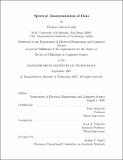Spectral anonymization of data
Author(s)
Lasko, Thomas A. (Thomas Anton), 1965-
DownloadFull printable version (13.03Mb)
Other Contributors
Massachusetts Institute of Technology. Dept. of Electrical Engineering and Computer Science.
Advisor
Peter Szolovits and Staal A. Vinterbo.
Terms of use
Metadata
Show full item recordAbstract
Data anonymization is the process of conditioning a dataset such that no sensitive information can be learned about any specific individual, but valid scientific analysis can nevertheless be performed on it. It is not sufficient to simply remove identifying information because the remaining data may be enough to infer the individual source of the record (a reidentification disclosure) or to otherwise learn sensitive information about a person (a predictive disclosure). The only known way to prevent these disclosures is to remove additional information from the dataset. Dozens of anonymization methods have been proposed over the past few decades; most work by perturbing or suppressing variable values. None have been successful at simultaneously providing perfect privacy protection and allowing perfectly accurate scientific analysis. This dissertation makes the new observation that the anonymizing operations do not need to be made in the original basis of the dataset. Operating in a different, judiciously chosen basis can improve privacy protection, analytic utility, and computational efficiency. I use the term 'spectral anonymization' to refer to anonymizing in a spectral basis, such as the basis provided by the data's eigenvectors. Additionally, I propose new measures of reidentification and prediction risk that are more generally applicable and more informative than existing measures. I also propose a measure of analytic utility that assesses the preservation of the multivariate probability distribution. Finally, I propose the demanding reference standard of nonparticipation in the study to define adequate privacy protection. I give three examples of spectral anonymization in practice. The first example improves basic cell swapping from a weak algorithm to one competitive with state of-the-art methods merely by a change of basis. (cont) The second example demonstrates avoiding the curse of dimensionality in microaggregation. The third describes a powerful algorithm that reduces computational disclosure risk to the same level as that of nonparticipants and preserves at least 4th order interactions in the multivariate distribution. No previously reported algorithm has achieved this combination of results.
Description
Thesis (Ph. D.)--Massachusetts Institute of Technology, Dept. of Electrical Engineering and Computer Science, 2007. This electronic version was submitted by the student author. The certified thesis is available in the Institute Archives and Special Collections. Includes bibliographical references (p. 87-96).
Date issued
2007Department
Massachusetts Institute of Technology. Department of Electrical Engineering and Computer SciencePublisher
Massachusetts Institute of Technology
Keywords
Electrical Engineering and Computer Science.